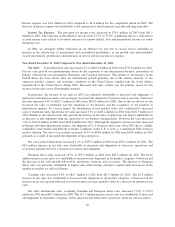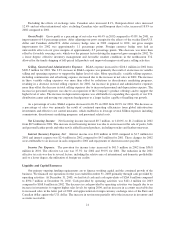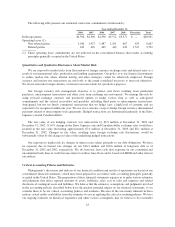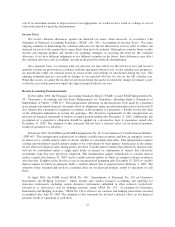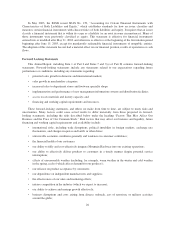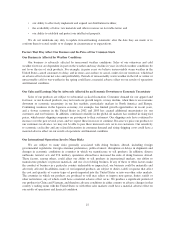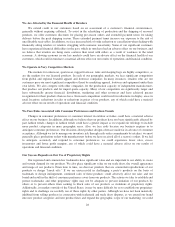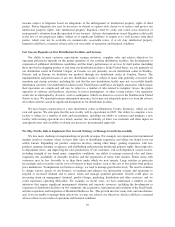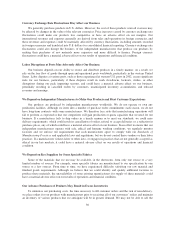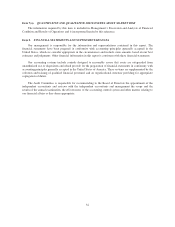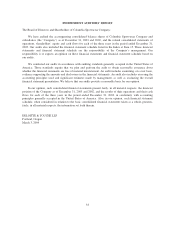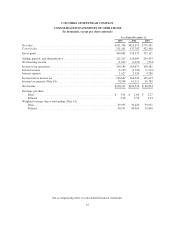Columbia Sportswear 2003 Annual Report Download - page 30
Download and view the complete annual report
Please find page 30 of the 2003 Columbia Sportswear annual report below. You can navigate through the pages in the report by either clicking on the pages listed below, or by using the keyword search tool below to find specific information within the annual report.sale. If we determine smaller or larger reserves were appropriate, we would record a credit or a charge to cost of
sales in the period we made the determination.
Income Taxes
We record valuation allowances against our deferred tax assets, when necessary, in accordance with
Statement of Financial Accounting Standards (“SFAS”) No. 109, “Accounting for Income Taxes.” We make
ongoing estimates in determining the valuation allowance for the net deferred tax asset in order to reduce our
deferred tax assets to the amount that is more likely than not to be realized. Although we consider future taxable
income and ongoing prudent and feasible tax planning strategies in assessing the need for the valuation
allowance, if we have different judgments or use different estimates in the future, these differences may affect
the valuation allowance and, accordingly, income in the period we made the determination.
On a quarterly basis, we estimate what our effective tax rate will be for the full fiscal year and record a
quarterly income tax provision in accordance with the anticipated effective rate. As the calendar year progresses,
we periodically refine our estimate based on actual events and earnings by jurisdiction during the year. This
ongoing estimation process can result in changes to our expected effective tax rate for the full calendar year.
When this occurs, we adjust the income tax provision during the quarter in which the change in estimate occurs
so that the year-to-date provision equals the expected annual effective tax rate.
Recent Accounting Pronouncements
In November 2002, the Financial Accounting Standards Board (“FASB”) issued FASB Interpretation No.
45, “Guarantor’s Accounting and Disclosure Requirements for Guarantees, Including Indirect Guarantees of
Indebtedness of Others” (“FIN 45”). This interpretation elaborates on the disclosures to be made by a guarantor
in its interim and annual financial statements about its obligations under specified guarantees that it has issued. It
also clarifies that a guarantor is required to recognize, at the inception of a guarantee, a liability for the fair value
of the obligation undertaken in issuing the guarantee. The disclosure requirements in this interpretation are
effective for financial statements of interim or annual periods ending after December 15, 2002. Additionally, the
recognition of a guarantor’s obligation should be applied on a prospective basis to guarantees issued after
December 31, 2002. The adoption of this statement did not have a material effect on our financial position,
results of operations or cash flows.
In January 2003, the FASB issued FASB Interpretation No. 46 “Consolidation of Variable Interest Entities”
(“FIN 46”). This interpretation explains how to identify variable interest entities and how an enterprise assesses
its interest in a variable interest entity to decide whether to consolidate that entity. This interpretation requires
existing unconsolidated variable interest entities to be consolidated by their primary beneficiaries if the entities
do not effectively disperse risks among parties involved. Variable interest entities that effectively disperse risks
will not be consolidated unless a single party holds an interest or combination of interest that effectively
recombines risks that were previously dispersed. This interpretation applies immediately to variable interest
entities created after January 31, 2003, and to variable interest entities in which an enterprise obtains an interest
after that date. It applies in the first fiscal year or interim period beginning after December 15, 2003, to variable
interest entities in which an enterprise holds a variable interest that it acquired before February 1, 2003. The
adoption of this statement did not have a material effect on our financial position, results of operations or cash
flows.
In April 2003, the FASB issued SFAS No. 149, “Amendments of Statement No. 133 on Derivative
Instruments and Hedging Activities,” which amends and clarifies financial accounting and reporting for
derivative instruments, including certain derivative instruments embedded in other contracts (collectively
referred to as derivatives) and for hedging activities under SFAS No. 133, “Accounting for Derivative
Instruments and Hedging Activities.” SFAS No. 149 is effective for contracts and hedging transactions executed
or modified after June 30, 2003. The adoption of this statement has not had a material effect on our financial
position, results of operations or cash flows.
25







